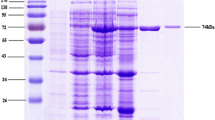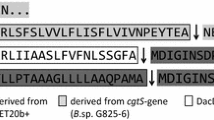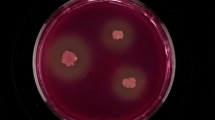Abstract
Cyclodextrin glycosyltransferases (CGTases) are widely used in starch deep processing, so reducing their cost by improving their production is of significant industrial interest. The CGTase from Bacillus stearothermophilus NO2 possesses excellent catalytic properties but suffers from low production in E. coli. In this study, directed evolution was used to create three point mutants (I631T, I641T and K647E) that were produced in E. coli with shake-flask yields 1.7-, 2.1-, and 2.2-fold higher than that of wild-type, respectively. The wild-type and K647E were then produced in a 3-L fermenter. The CGTase activity of the K647E (1904 U mL-1) was 2.0-fold higher than that of the wild-type. The K647E fermentation supernatant could be used directly to prepare 2-O-α-d-glucopyranosyl-l-ascorbic acid, reducing the costs associated with its production. Structural modeling of the three mutants suggested that hydrophilicity, hydrogen bonding, and negative charge may be responsible for their improved production. Since K647 is conserved in the CGTase family, the corresponding residues in the CGTases from Bacillus circulans 251, Paenibacillus macerans, and Anaerobranca gottschalkii were changed to glutamic acid. Productions of the resulting K647E mutants were 2.0-, 1.5-, and 1.0-fold higher than those of their respective wild-types. Electrostatic protein surface analysis suggested that mutations occurring at low negative surface charge may increase CGTase production.







Similar content being viewed by others
References
Bradford MM (1976) A rapid and sensitive method for the quantitation of microgram quantities of protein utilizing the principle of protein-dye binding. Anal Biochem 72:248–254. https://doi.org/10.1006/abio.1976.9999
Carvajal-Vergara X, Sevilla A, D'Souza SL, Ang Y-S, Schaniel C, Lee D-F, Yang L, Kaplan AD, Adler ED, Rozov R, Ge Y, Cohen N, Edelmann LJ, Chang B, Waghray A, Su J, Pardo S, Lichtenbelt KD, Tartaglia M, Gelb BD, Lemischka IR (2010) Patient-specific induced pluripotent stem-cell-derived models of LEOPARD syndrome. Nature 465(7299):808–812. https://doi.org/10.1038/nature09005
Cheng J, Wu D, Chen S, Chen J, Wu J (2011) High-level extracellular production of alpha-cyclodextrin glycosyltransferase with recombinant Escherichia coli BL21 (DE3). J Agric Food Chem 59(8):3797–3802. https://doi.org/10.1021/jf200033m
Chiti F, Stefani M, Taddei N, Ramponi G, Dobson CM (2003) Rationalization of the effects of mutations on peptide and protein aggregation rates. Nature 424(6950):805–808. https://doi.org/10.1038/nature01891
Deng C, Li J, Shin H-D, Du G, Chen J, Liu L (2018) Efficient expression of cyclodextrin glycosyltransferase from Geobacillus stearothermophilus in Escherichia coli by promoter engineering and downstream box evolution. J Biotechnol 266:77–83. https://doi.org/10.1016/j.jbiotec.2017.12.009
Deng C, Lv X, Li J, Liu Y, Du G, Amaro RL, Liu L (2019) Synthetic repetitive extragenic palindromic (REP) sequence as an efficient mRNA stabilizer for protein production and metabolic engineering in prokaryotic cells. Biotechnol Bioeng 116(1):5–18. https://doi.org/10.1002/bit.26841
Fernandez-Escamilla AM, Rousseau F, Schymkowitz J, Serrano L (2004) Prediction of sequence-dependent and mutational effects on the aggregation of peptides and proteins. Nat Biotechnol 22(10):1302–1306. https://doi.org/10.1038/nbt1012
Guo Y, Chen J, Jia X, Lin X (2016) Effects of chaperone co-expression on heterologous solubility expression of thermophilic cyclodextrin glucosetransferase. Microbiology China 43(3):518-526. doi:10.13344/j.microbiol.china.150453
Han R, Li J, H-d S, Chen RR, Du G, Liu L, Chen J (2014) Recent advances in discovery, heterologous expression, and molecular engineering of cyclodextrin glycosyltransferase for versatile applications. Biotechnol Adv 32(2):415–428. https://doi.org/10.1016/j.biotechadv.2013.12.004
Jiang S, Li C, Zhang W, Cai Y, Yang Y, Yang S, Jiang W (2007) Directed evolution and structural analysis of N-carbamoyl-D-amino acid amidohydrolase provide insights into recombinant protein solubility in Escherichia coli. Biochem J 402:429–437. https://doi.org/10.1042/bj20061457
Kramer RM, Shende VR, Motl N, Pace CN, Scholtz JM (2012) Toward a molecular understanding of protein solubility: increased negative surface charge correlates with increased solubility. Biophys J 102(8):1907–1915. https://doi.org/10.1016/j.bpj.2012.01.060
Kyte J, Doolittle RF (1982) A simple method for displaying the hydropathic character of a protein. J Mol Biol 157(1):105–132. https://doi.org/10.1016/0022-2836(82)90515-0
Leemhuis H, Kelly RM, Dijkhuizen L (2010) Engineering of cyclodextrin glucanotransferases and the impact for biotechnological applications. Appl Microbiol Biotechnol 85(4):823–835. https://doi.org/10.1007/s00253-009-2221-3
Li P, Guan H, Li J, Lin ZL (2009) Heterologous expression, purification, and characterization of cytochrome P450sca-2 and mutants with improved solubility in Escherichia coli. Protein Expr Purif 65(2):196–203. https://doi.org/10.1016/j.pep.2008.11.012
Li Y, Liu J, Wang Y, Liu B, Xie X, Jia R, Li C, Li Z (2017) A two-stage temperature control strategy enhances extracellular secretion of recombinant alpha-cyclodextrin glucosyltransferase in Escherichia coli. AMB Express 7(1):165. https://doi.org/10.1186/s13568-017-0465-3
Li Z, Li B, Gu Z, Du G, Wu J, Chen J (2010) Extracellular expression and biochemical characterization of alpha-cyclodextrin glycosyltransferase from Paenibacillus macerans. Carbohydr Res 345(7):886–892. https://doi.org/10.1016/j.carres.2010.02.002
Lombard V, Ramulu HG, Drula E, Coutinho PM, Henrissat B (2014) The carbohydrate-active enzymes database (CAZy) in 2013. Nucleic Acids Res 42(D1):D490–D495. https://doi.org/10.1093/nar/gkt1178
McLoughlin SY, Jackson C, Liu JW, Ollis D (2005) Increased expression of a bacterial phosphotriesterase in Escherichia coli through directed evolution. Protein Expr Purif 41(2):433–440. https://doi.org/10.1016/j.pep.2005.01.012
Melzer S, Sonnendecker C, Follner C, Zimmermann W (2015) Stepwise error-prone PCR and DNA shuffling changed the pH activity range and product specificity of the cyclodextrin glucanotransferase from an alkaliphilic Bacillus sp. Febs Open Bio 5:528–534. https://doi.org/10.1016/j.fob.2015.06.002
Mo H-M, Xu Y, Yu X-W (2018) Improved soluble expression and catalytic activity of a thermostable esterase using a high-throughput screening system based on a split-GFP assembly. J Agric Food Chem 66(48):12756–12764. https://doi.org/10.1021/acs.jafc.8b04646
Mosavi LK, Peng ZY (2003) Structure-based substitutions for increased solubility of a designed protein. Protein Eng 16(10):739–745. https://doi.org/10.1093/protein/gzg098
Overton TW (2014) Recombinant protein production in bacterial hosts. Drug Discov Today 19(5):590–601. https://doi.org/10.1016/j.drudis.2013.11.008
Qi QS, Zimmermann W (2005) Cyclodextrin glucanotransferase: from gene to applications. Appl Microbiol Biotechnol 66(5):475–485. https://doi.org/10.1007/s00253-004-1781-5
Reetz MT, Zheng HB (2011) Manipulating the expression rate and enantioselectivity of an epoxide hydrolase by using directed evolution. ChemBioChem 12(10):1529–1535. https://doi.org/10.1002/cbic.201100078
Robert X, Gouet P (2014) Deciphering key features in protein structures with the new ENDscript server. Nucleic Acids Res 42(W1):W320–W324. https://doi.org/10.1093/nar/gku316
Song B, Yue Y, Xie T, Qian S, Chao Y (2014) Mutation of Tyrosine167Histidine at Remote Substrate Binding Subsite-6 in alpha-Cyclodextrin Glycosyltransferase Enhancing alpha-Cyclodextrin Specificity by Directed Evolution. Mol Biotechnol 56(3):232–239. https://doi.org/10.1007/s12033-013-9699-8
Sonnendecker C, Wei R, Kurze E, Wang J, Oeser T, Zimmermann W (2017) Efficient extracellular recombinant production and purification of a Bacillus cyclodextrin glucanotransferase in Escherichia coli. Microb Cell Factories 16(1):87. https://doi.org/10.1186/s12934-017-0701-1
Sonnendecker C, Zimmermann W (2019a) Change of the product specificity of a cyclodextrin glucanotransferase by semi-rational mutagenesis to synthesize large-ring cyclodextrins. Catalysts 9(3):242. https://doi.org/10.3390/catal9030242
Sonnendecker C, Zimmermann W (2019b) Domain shuffling of cyclodextrin glucanotransferases for tailored product specificity and thermal stability. Febs Open Bio 9(2):384–395. https://doi.org/10.1002/2211-5463.12588
Su L, Ma Y, Wu J (2015) Extracellular expression of natural cytosolic arginine deiminase from Pseudomonas putida and its application in the production of L-citrulline. Bioresour Technol 196:176–183. https://doi.org/10.1016/j.biortech.2015.07.081
Sun LH, Petrounia IP, Yagasaki M, Bandara G, Arnold FH (2001) Expression and stabilization of galactose oxidase in Escherichia coli by directed evolution. Protein Eng 14(9):699–704. https://doi.org/10.1093/protein/14.9.699
Suominen I, Karp M, Lähde M, Kopio A, Glumoff T, Meyer P, Mäntsälä P (1987) Extracellular production of cloned α-amylase by Escherichia coli. Gene 61(2):165–176. https://doi.org/10.1016/0378-1119(87)90111-9
Tao X, Wang T, Su L, Wu J (2018) Enhanced 2-O-alpha-d-glucopyranosyl-l-ascorbic acid synthesis through iterative saturation mutagenesis of acceptor subsite residues in Bacillus stearothermophilus NO2 cyclodextrin glycosyltransferase. J Agric Food Chem 66(34):9052–9060. https://doi.org/10.1021/acs.jafc.8b03080
Tesfai BT, Wu D, Chen S, Chen J, Wu J (2013) Effect of organic solvents on the yield and specificity of cyclodextrins by recombinant cyclodextrin glucanotransferase (CGTase) from Anaerobranca gottschalkii. J Incl Phenom Macr 77(1-4):147–153. https://doi.org/10.1007/s10847-012-0225-6
van der Veen BA, Leemhuis H, Kralj S, Uitdehaag JCM, Dijkstra BW, Dijkhuizen L (2001) Hydrophobic amino acid residues in the acceptor binding site are main determinants for reaction mechanism and specificity of cyclodextrin-glycosyltransferase. J Biol Chem 276(48):44557–44562. https://doi.org/10.1074/jbc.M107533200
Wang L, Chen S, Wu J (2018) Cyclodextrin enhanced the soluble expression of Bacillus clarkii γ-CGTase in Escherichia coli. BMC Biotechnol 18(1):72. https://doi.org/10.1186/s12896-018-0480-8
Willemot K, Cornelis P (1983) Growth defects of Escherichia coli cells which contain the gene of an α-amylase from Bacillus coagulans on a multicopy plasmid. Microbiology 129(2):311–319. https://doi.org/10.1099/00221287-129-2-311
Yang Y, Wang L, Chen S, Wu J (2014) Optimization of beta-cyclodextrin production by recombinant beta-cyclodextrin glycosyltransferase. Biotechnol Bull(8):175-181. https://doi.org/10.13560/j.cnki.biotech.bull.1985.2014.08.031
Zhang YB, Howitt J, McCorkle S, Lawrence P, Springer K, Freimuth P (2004) Protein aggregation during overexpression limited by peptide extensions with large net negative charge. Protein Expr Purif 36(2):207–216. https://doi.org/10.1016/j.pep.2004.04.020
Funding
This study was financially supported by the National Natural Science Foundation of China (31730067, 31771916), the Science and Technology Project of Jiangsu Province - Modern Agriculture (BE2018305), the Natural Science Foundation of Jiangsu Province (BK20180082), National first-class discipline program of Light Industry Technology and Engineering (LITE2018-03), and the Postgraduate Research & Practice Innovation Program of Jiangsu Province (KYCX19_1832).
Author information
Authors and Affiliations
Corresponding author
Ethics declarations
Conflict of interest
The authors declare that they have no conflicts of interests.
Ethical statement
This article does not contain any studies with human participants or animals performed by any of the authors.
Additional information
Publisher’s note
Springer Nature remains neutral with regard to jurisdictional claims in published maps and institutional affiliations.
Electronic supplementary material
ESM 1
(PDF 182 kb)
Rights and permissions
About this article
Cite this article
Tao, X., Su, L., Wang, L. et al. Improved production of cyclodextrin glycosyltransferase from Bacillus stearothermophilus NO2 in Escherichia coli via directed evolution. Appl Microbiol Biotechnol 104, 173–185 (2020). https://doi.org/10.1007/s00253-019-10249-8
Received:
Revised:
Accepted:
Published:
Issue Date:
DOI: https://doi.org/10.1007/s00253-019-10249-8




